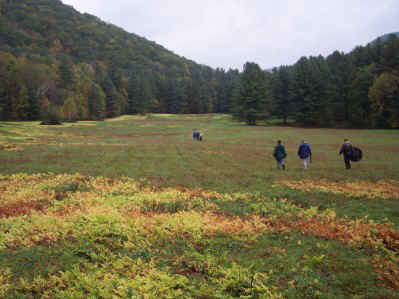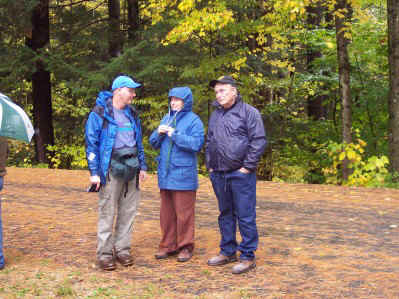|
ENTS:
I am a person who constantly looks to the past to gauge where I
am in the present and to predict or even to try to shape the
future. In reviewing the progression of events, sometimes I
shake my head in amazement at the state of things at the
starting line versus how they developed along the way, sometimes
through forethought and sometimes entirely serendipitously.
 photo by Carl Harting
photo by Carl Harting
The concept for the Eastern Native Tree Society, ENTS, began largely as
fun-filled ideas being kicked around in a trailer in the
Nantahala mountains of eastern North Carolina by Will Blozan,
Norma Ivey, Rob Messick, Jani Leverett, myself, and a few
others. A subsequent formal birth of ENTS at my kitchen table
with David Stahle, Michael Perlman, Will Blozan, Matt Therrell,
and myself giving substance to what might have been a mere
passing fancy seems as though some unseen force was guiding us.
But what has happened sense is truly more like a dream
orchestrated from the world of spirit and ideas than as a
sequence of improbable events. I suspect that the ideas and
commitments that characterize the ENTS of today have bounced
around in the heads of many. Some souls have acted locally and
without fanfare and that is where the results of their efforts
can be seen. God bless them. I sometimes think that the
launching of the actual ENTS organization and its subsequent
growth can only be understood as the work of either divinely
inspired or thoroughly obsessed people. And the numbers of
inspired or obsessed has grown. The ENTS of today is a much more
potent and resourceful organization than it was in the early
years.
 photo by Carl Harting
photo by Carl Harting
On Saturday, as I watched Will Blozan climb high into the Massasoit tree
in a rain with intensely focused tree measurers going about
their craft at the base of the tree, for a moment the scene
became surrealistic. Why here, why us? I asked that question
without expecting an answer. But it seemed so improbable. Here
were very smart, accomplished people who came from far of places
like Minnesota, North Carolina, Ohio, and Pennsylvania while
most of the local population around Mohawk Trail State Forest
never even visits the place. The local populace knows next to
nothing about Mohawk. They care even less. It set me to
thinking.
My comment about the locals isn't meant as a specific criticism toward the
citizens of Charlemont Massachusetts. The comment is intended as
a general recognition of how locals often relate to natural
treasurers under their very noses. To take nothing away from the
visionaries of a place, as a group, the Charlemont locals are
not a whet different than the majority of citizens surrounding
dozens of other great forest sites in the East. Indifference by
locals is in the nature of our materialistic society and our
human value system. But there we were, a group apart, doing
something entirely inscrutible and utterly pointless to the
predominant value system of our society. We were measuring
trees.
 photo by Carl Harting
photo by Carl Harting
Certainly, the incentives for us Ents to have spent our time on Saturday
doing something other than measuring trees in the rain would
seem to have been overwhelming. There was the major league
playoffs to watch, casinos to visit, high impact recreation,
home projects, shopping. Yet there we were, measuring a tree in
the rain. We the faithful were not the least bit tempted to be
elsewhere. As Will climbed higher and higher, I was willing to
bet there was no place that he'd rather be, rain or shine, less
it be in another great tree.
On Saturday evening, when my partner professor Monica Jakuc put
together an absolutely splendid concert for ENTS, I thought to
myself, "what and extraordinary thing that is happening
here." Monica had caught the spirit. She had acquired the
vision. ENTS deserved her support. As I watched Dr. Lee Frelich
stand with violin in hand ready to play even after a 20-year
layoff, I thought to myself, "how can he be doing
this?". Was he performing because he was being guided by
invisible forces that deem our cause important? After all, Lee
Frelich does not have to get into a car and drive 1000 miles to
make a presentation for which he receives no remuneration. Lee
is in constant demand. His star as a scientist is recognized as
having risen. He does not lack for status. His voice is now a
very significant one within the community of scientists. He
certainly needs no platform from us. No at all. He is doing what
he is doing from a sense of inner knowing. He recognizes the
value of ENTS and how our organization fits into or can fit into
a much larger picture. He knows that we are not replacing
anything that currently exists, but that we are adding value by
giving forest places a form and voice beyond mere data in ways
that transcend existing professions, interests, and purposes. He
wouldn't have been standing there playing his violin had he not
had the vision of an ENTS mission.
At such times of reflection, Cook Forest always returns to me as
a strong focus for what ENTS has accomplished and is about.
Remembering that Cook Forest was established by people of
sensitivity and vision, people who wanted the remnant great pine
forest to keep alive a spirit that had been largely lost as
Pennsylvania's primary forest shrank to insignificance. Cook
Forest State Park was being managed perfunctorily by officials
who knew little about its forest history and absolutely nothing
about its great trees. A tree was a tree was a tree. Officials
invariably became imprisoned in day to day schedules and in
seeing to the needs of throngs of visitors who often had only
slight awareness of the trees that surrounded them, beyond the
trees as a nondescript forest backdrop for recreation. In 1994
when I came to meet the local managment of Cook Forest, the very
reason for the existence of that state park had became lost in
managing human trivia. It was also lost in the misplaced
values of the state resource manager who saw the need to cull
out dying pines and prostrate logs, which they perceived as the
carriers of diseases ready to sweep through the entire grove in
a matter of years. I talked with state managers who saw the
standing pines valuable only as potential timber. Even if the
actual trees were never cut, they saw their job as that of
maintaining the economic potential of the forest. Who knows,
maybe they would get their chance to create a "real
forest"? Before Anthony Cook's crusade, assistance from
ENTS, and the rise of Dale Luthringer, the great trees of Cook
Forest were just a woodsy backdrop to recreation. The pines were
anonymous. No, that wasn't true for everyone. For visitors with
a sense of history, I'm sure it was different. They saw the
swaying pines as speaking eloquently of times long gone by, but
often only as symbols of a romantic past rather than living
organisms that had earned a right to be noticed, honored, and
protected. Today the atmosphere is different in Cook Forest, at
least in degree, as it is elsewhere. In fact we have several
impressive success stories to share with those who value our
forest parks.
Zoar Valley, and even in the GSMNP, which has never lacked for attention
or appreciation, reflect the hand of ENTS. With the Smokies, it
is an inspiting story, one of a cooperative venture. The Park
people like ENTS and what we do. ENTS has a partnership with the
GSMNP. However, with Zoar Valley versus New York's DEC, our role
has been more confrontational. There the uniqueness and value of
the Zoar forest as a natural area of incredible ecological value
has to be constantly proven through hard science. The
bureaucrats have been hard to persuade. Exploitative forces have
never been far from the gates.
As for my forest Mecca, I could write a book about Mohawk Trail State
Forest's prolonged period of anonymity, save for its use for
convenient camping and as a staging area for river rafting. But
thanks to ENTS, Mohawk is finally being recognized by
officialdom as one of the great tree parks of the Northeast. Its
recognition as such by state officials has been slow to grow,
but I can state categorically that it is happening. However, we
dare not take our eye off the ball, even for an instant, least
exploitative forces lurking in dark places find other purposes
for the tall pines, the peaceful meadows, and the all important
area of river front. Mohawk's accessibility to the public,
courtesy of State Route #2 , is guaranteed not to escape the
notice of economically motivated development interests.
So what has the stream of reflections that were triggered by the past
weekend's events led me to conclude? Well, we do have our
supporters in the general public. But that is not where we have
had the most impact. ENTS is making a significant contribution
to the tricky process of increasing "official
awareness" of and appreciation for federal and state forest
parks in the East, especially with respect to where a porperty
fits into the greater scheme of things. Minds of public
officials who manage regional, state, and federal parks and
forests are being opened up. As their legal custodians, if
garnering their appreciation and understanding for the exemplary
forest parks and individual trees under the watch of federal,
state, and localmanagers is all that ENTS were ever to
accomplish, it would be no small achievement.
Bob
Robert T.
Leverett
Cofounder, Eastern Native Tree Society
|